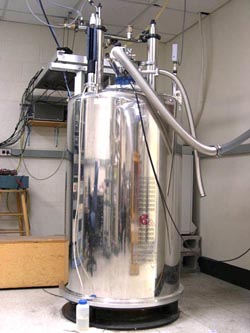Slideshow . . 1 . . 2 . . 3

140 GHz EPR/ ENDOR
NW14
<< Back to Spectrometers |
140 GHz EPR/ ENDOR
Introduction
The 140 GHz EPR spectrometer has been developed in the center over the past decade to permit state-of-the-art pulsed EPR experiments at high microwave frequency. The spectrometer is equipped with a home-built microwave bridge and a console for electron nuclear double resonance. Routine double resonance techniques complement ENDOR hyperfine spectroscopy and Dynamic Nuclear Polarization (DNP). Our main collborative research consists in expanding current limits in spectral sensitivity and resolution to investigate the electronic and chemical structure of paramagnetic proteins. Several collaborative works are ongoing, in particular on the catalytic cycle of Ribonucleotide Reductases, 2Fe2S-ferredoxins and single and doubly spin-labeled peptides. For more details about our research see our recent publications.
Magnet system
The 5 Tesla magnetic field consists of a two coil superconducting magnet (Magnex Corporation) with a 130 mm room-temperature bore. A small superconducting sweep coil allows for field sweeps of +/- 0.4 T. The low current required for field sweep (13 A) minimizes the helium boil-off rate. A home built NMR teslameter permits magnetic field settings and sweeps within 1 Gauss precision. The magnet is equiped with a flow cryostat (Oxford Instruments) for temperature control between 2 and 400 K.
Microwave-Bridge
The microwave bridge (picture) is based on a heterodyne detection scheme. The microwave sources are two InP Gunn diodes (Millimeter Wave Oscillator) operating at 139.5 (main source) and 139.95 GHz (reference) phase locked to a 50 MHz source. The difference between the main and the reference frequencies represent the intermediate frequency of 450 MHz. Microwave power amplification is achieved with an IMPATT diode network (Donetsk Physico Technical Institute). A combination of fast amplitude and 0-90, 0 -180 degree phase switches leads to 37 mW output power and microwave pulses with < 10 ns rise and fall times.The microwaves are conducted to the resonator using a combination of oversized and fundamental waveguides (WR-42 and WR-8), tapers and bends. Insertion losses attenuate the incident power at the resonator to approximately 5 mW.
140 GHz EPR/ENDOR Cavities
To date, only cylindrical resonators operating in TE011 mode have been established for high-frequency pulsed EPR. In our set-up, tuning is achieved with a fixed and a moveable plunger, while microwave coupling into the cavity is established through a circular, centered iris. To allow for additional radio-frequency irradiation in ENDOR and DNP experiments, we have designed and implemented two modifications of the TE011 cavity. In the first modification, slots are cut through the cylindrical wall perpendicular to the resonator z-axis. This cavity displays high mechanical stability at low temperatures and is well suited for routine ENDOR experiments. In the second modification, the body of the cavity is replaced by a flat wire, which simultaneously acts as a radio-frequency coil (picture). The structure permits efficient double resonance irradiation but is very sensitive to mechanical displacements. It is well suited for the investigation of complex pulsed polarization transfer experiments. |

